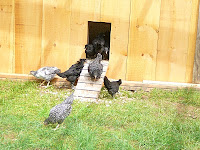It seems a shame that CSB does not keep a diary. (To paraphrase OW: I never travel without mine; I like to have something sensational to read in the veterinarian’s waiting room.) Then he, like Samuel Pepys, could write about the pain of his kidney stone and all the attendant indignities and miseries, or like Pepys he could host a party every year to celebrate the anniversary of the removal of said kidney stone. We would serve lots of fluids.
And in news from the farm:
Yesterday morning I got a call at 7 AM from our post office, letting me know that our day-old chicks had arrived. Jan the friendly postmaster (and devotee of local honey) was worried that they would get cold in the air conditioned back room. So I rushed down there, though not in pajamas, and picked up the new chicks:

5 Araucanas to lay blue & green eggs, 5 Plymouth Rocks & 5 Speckled Wyandottes, and 1 extra thrown in for good measure. All pullets. They were all sexed upon birth, but not by me. They came in a 10x10x5” cardboard box with a few holes in it and it goes without saying that they are very cute in the way that many creatures are much cuter in their first weeks of existence then they will ever be again.

You may well ask why we need more chicks when we already have 15 chickens and the answer is that we were concerned lest too many of those chickens turn out to be roosters. (also, see above.) So far only one has identified himself incontrovertibly as a rooster (named Alonso)and I am doing my best not to get attached to his crowing and strutting.
This past week I spent a few profitable hours at BEA (Book Expo America) thanks to my dear friend, Meg. The purpose of this convention, the reason publishers from all over America and the world gather at Jacob Javits and set up booths and look weird under the fluorescent lights, is to give away books & bookmarks & ARCs (Advanced Review Copies) to people like me who think the getting free books is better than dark chocolate. This year I got especially lucky and snagged an ARC of the new Jane Gardam, God on the Rocks. (This came out in Britain in 1978 and is only now coming out here with Europa. I love their editions as they are so Euro-looking, unsurprisingly.) I started it last night and read this sentence, which pretty much made my day and evening and then some: “Some gulf obtained between Margaret and children with undecorated backs.”
The following, overheard as I emerged from the hardware store (a rare outing since I don’t like to leave the suffering CSB and his kidney stone) with a new heat lamp for the chicks, may prove to be today’s best quote:
A young couple to their two young children (ages 4? 5?),“We’re going to go in there and Mommy and Daddy are going to get adjusted & you can get adjusted too if you want.”
One small child to the other, eagerly: “Lena, do you want to get adjusted?”
I learned today that the incidence of kidney stones will only get worse with Global Warming. I read this in Wikipedia and was somewhat dubious, but then I spoke with the eminent Dr David Goldfarb, Nephrologist, Kidney Stonologist, ballroom dancer and chef, who assured me that this is true. As people sweat more they urinate less and the urine is then concentrated and this leads to kidney stones. A rise of even one degree in temperature could effectively move the current “kidney stone belt” of the south to our own backyard.


















